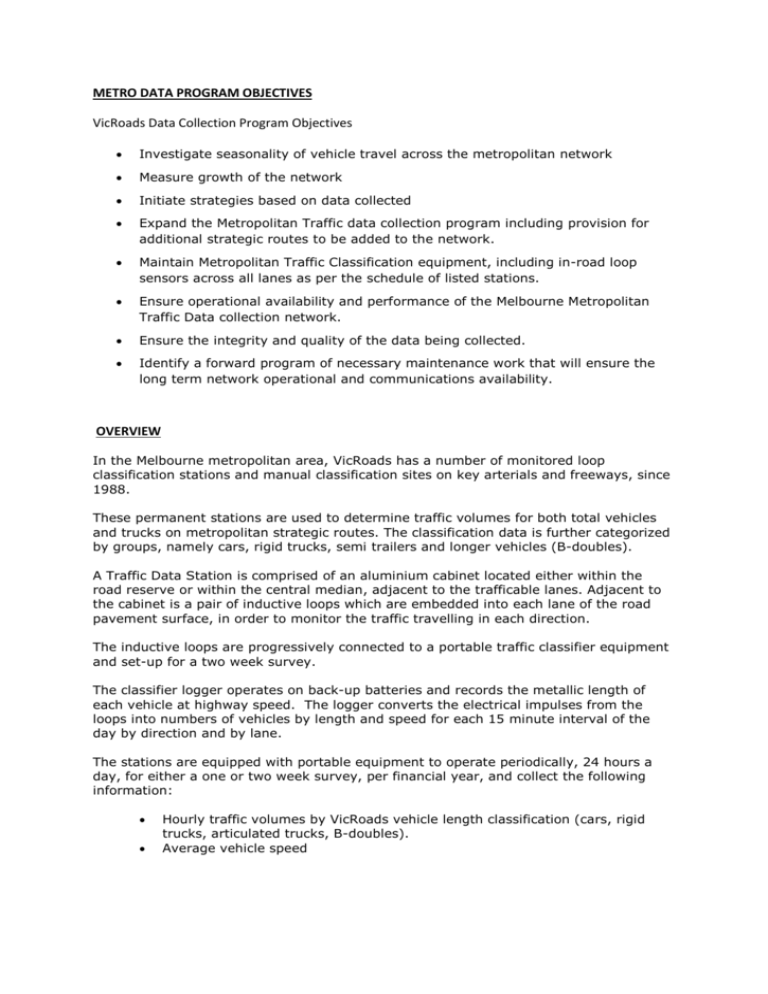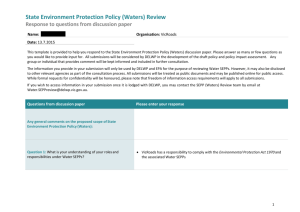Metro traffic data draft specifications
advertisement

METRO DATA PROGRAM OBJECTIVES VicRoads Data Collection Program Objectives Investigate seasonality of vehicle travel across the metropolitan network Measure growth of the network Initiate strategies based on data collected Expand the Metropolitan Traffic data collection program including provision for additional strategic routes to be added to the network. Maintain Metropolitan Traffic Classification equipment, including in-road loop sensors across all lanes as per the schedule of listed stations. Ensure operational availability and performance of the Melbourne Metropolitan Traffic Data collection network. Ensure the integrity and quality of the data being collected. Identify a forward program of necessary maintenance work that will ensure the long term network operational and communications availability. OVERVIEW In the Melbourne metropolitan area, VicRoads has a number of monitored loop classification stations and manual classification sites on key arterials and freeways, since 1988. These permanent stations are used to determine traffic volumes for both total vehicles and trucks on metropolitan strategic routes. The classification data is further categorized by groups, namely cars, rigid trucks, semi trailers and longer vehicles (B-doubles). A Traffic Data Station is comprised of an aluminium cabinet located either within the road reserve or within the central median, adjacent to the trafficable lanes. Adjacent to the cabinet is a pair of inductive loops which are embedded into each lane of the road pavement surface, in order to monitor the traffic travelling in each direction. The inductive loops are progressively connected to a portable traffic classifier equipment and set-up for a two week survey. The classifier logger operates on back-up batteries and records the metallic length of each vehicle at highway speed. The logger converts the electrical impulses from the loops into numbers of vehicles by length and speed for each 15 minute interval of the day by direction and by lane. The stations are equipped with portable equipment to operate periodically, 24 hours a day, for either a one or two week survey, per financial year, and collect the following information: Hourly traffic volumes by VicRoads vehicle length classification (cars, rigid trucks, articulated trucks, B-doubles). Average vehicle speed The Metropolitan Traffic Data “Loop” network currently consists of 92 permanent traffic classification stations (115 roadside cabinets), which are strategically located on the VicRoads Melbourne metropolitan declared road network. Currently, the operational availability of the network is 92%, with 80 Active Sites. (refer Site List below). VicRoads currently has a fleet of battery operated automatic vehicle classification equipment which are rotated in and out of these stations following the completion of the 2 week survey. The cabinets are located in the metropolitan area along major arterial roads including Highways and Freeways, and are subjected to climatic and environmental changes that can affect the operation of the equipment. Cabinets are not IP rated or insulated which means the equipment will be subject to variations in temperature, moisture and insect infestation. The loop station operational availability is periodically affected by roadworks that requires the reinstatement of the inductive loops and associated re-cabling. Approximately, 10% of the network is affected by roadworks in any given year. The maintenance of the Metro Loop network is critical to ensuring the timely collection and the quality assurance of traffic data prior to loading into the Corporate "Traffic_Stats" database. The maintenance program incorporates the tracking of the equipment’s operational status, performing volume/classification verification and calibration tests. Routine maintenance inspections (at least 1 per year) are carried out to optimise the performance of the network and preventative measures are taken to compensate for wear and tear. i.e. crack sealing of loops. The maintenance of the Metro Loop station network infrastructure, requires a dedicated maintenance program to ensure the network is in a state of continuous and effective operational availability, prior to installing portable survey equipment. The program includes performing on-site visual observation testing, inspections/fault monitoring and general equipment/sensor maintenance, in order to deliver continuous traffic volume and classification data on the Metro Loop network. DRAFT TECHNICAL SPECIFICATION - MANDATORY CRITERIA In order for a product to be considered “fit for purpose” it must meet the mandatory criteria listed. The Service Provider is required to specify the device type best suited for this application. Technology must, detect, count and classify and measure speed of only “true positive” all vehicular traffic events (including motorcycles), estimation algorithms are not permitted to be used to count or classify vehicle events. Technology must be able to resolve straddling vehicle events, to achieve the mandatory performance and accuracy criteria mentioned below for the mix of traffic located on major arterial and freeways. Equipment must be IP rated and vermin proof (at least IP65) All the input and output ports, including cable connectors plugs and sockets, shall be manufactured to Mil-Spec requirement, and high quality precision. Connectors shall facilitate true and positive connection every time they are plugged in. As a guide, VicRoads existing counting equipment uses a three start thread with 1 to 3 locating lugs. Sufficient "Internal" battery life and memory to conduct a 2 week survey connected to sensors monitoring up to 12 lanes of traffic Logger able to be configured to Calculate & Record Classification and Speed matrix (Interval Surveys). Special Consideration may be given to VBV event loggers. (Preference will be given to equipment capable of recording Interval Surveys as well as VBV individual records) The VBV component of the Logger shall have sufficient Memory storage capacity to record a minimum of 10 Million VBV events at high volume Freeway sites, monitoring up to 12 lanes of traffic. To avoid a network of hybrid technologies, the proposed network of Intrusive/Non-Intrusive data acquisition technology must be homogeneous across the Metropolitan Traffic data collection network. As a guide VicRoads currently uses a fleet of automatic vehicle classification equipment which is either a 4 lane 8 channel logger (arterial roads), or 8 lane 16 channel logger (freeways). Note: Two or more loggers may be required to co-exist inside cabinets when monitoring 6 -8 lanes of Highway/Freeway traffic. The Service Provider must demonstrate that any possible Multi-Plexing (EMF) affects between the two electronic logger units have been resolved or neutralised prior to commencing a survey. If the network of Traffic Data stations were placed on VPN modem network, rack mounted loggers to suit lane configuration may be adopted. Real-Time View of traffic to verify what you see is what is being recorded into logger memory shall be provided, via both Telemetry and direct lap-top connection to the Classifier. The Service Provider shall supply VicRoads with logger communications software that shall have the ability to display the actual Real-Time recording of every vehicle by individual channels, i.e. as a vehicle event is detected by the in-road or non-intrusive sensor, the operator must be able to physically observe on the logger’s LCD and/or connected PC screen: lane number, classification, speed and the accumulated count for this same classification. The accumulated tally count for all traffic in all lanes and accumulated tally count for all traffic in individual lanes must be readily available in order to verify equipment is recording correctly prior to commencing survey as this is critical in order for scheduled MO counts to proceed. Loop based In-road Sensors shall have a resolution < or = 5 milliseconds Loop technology Sensitivity and adjustment:- Each channel of the Classifier (each loop pair) shall have separate sensitivity adjustment regarding loop length and separation. Each channel of the Classifier (preferably each loop) shall have the facility whereby the sensitivity can be adjusted with regards to the loop signal strength. Minimum 5 year design life of “intrusive” “non-intrusive” detector sensors Classifier equipment using in-road sensors shall also be equipped with lightning suppression and dissipation circuitry, which will isolate and protect the firmware and hardware from surge damage. Loop based technology shall have the ability to invoke a Vehicle Signature Algorithm function that will enable the chassis height to be determined, hence able to distinguish buses from Rigid trucks, cars towing trailers from Rigid trucks, Buses and Vans from Rigid trucks. (i.e. a truncated AustRoads class scheme) Loop based technology must be able to handle long Loop Feeder Cables at least 250m Type Approval and 3rd party endorsement of Proven and Mature Equipment. Only tried and proven 3rd Party certified technologies accepted (Note: At VicRoads’ discretion, special consideration may be given to experimental equipment, only if it exceeds cost benefit and performance criteria) SERVICE DELIVERY - MANDATORY CRITERIA Provider to develop and supply to VicRoads a Data validation Tool similar to the Excel Tool currently used by VicRoads field staff to validate data prior to delivery. Type approval trials shall be conducted over two 2 hour Peak hour manual count surveys, at sites which are affected by queuing 1 month technology trial prior to awarding contract – Demonstrating ability to resolve Straddling & Concatenation at congested test site, as well as demonstrating mandatory performance criteria has been met. Service Provider responsible for chasing up and managing Loop reinstatement costs with VicRoads Regions should existing infrastructure of “in-road” Loop detector network is adopted Service Provider to supply VicRoads with Schedules of surveys (Gantt Chart) so that spot Audits can be performed and in order to synchronise MO counts Surveys are to be scheduled evenly across the VicRoads recommended collection period and not all done in the 1st semester or 2nd semester of the year. Service Provider responsible for re-scheduling synchronised MO counts (with VicRoads 3rd party observational survey contractor) and confirm changes to VicRoads, where surveys do not proceed within scheduled 2 week survey time frame. Re-scheduling surveys must be kept at a minimum, approved by VicRoads, and only be attributable to unforeseen circumstances outside the Service Provider’s control such as roadworks damaging in-road sensors. The Service Provider shall be required to attend fault call-outs issued by VicRoads and based on VicRoads and/or the Service Provider having identified data quality or system fault issues. Should these faults occur during the two week survey period (in which MO counts are being conducted), the survey and MO count shall be repeated and MO count rescheduled, respectively, at the Service Provider’s cost; within 1 month, Non-Holiday survey period, within financial year, capped off at no more than 5 per year, and conducted within achievable time frame and lead time. Service Provider will be required to provide VicRoads with a schedule of rates costing for additional surveys (Variations) at existing or new proposed sites, based on a fixed Rate agreed to in the contract. Communications/feedback - Service Provider needs to be contactable within 48 hours, attend monthly progress meetings and be issued with and respond to fault attendance call-outs. “Sign Off” Maintenance reports to be provided 4 to 6 weeks in advance of commencement of survey As a minimum, the Service Provider is required to store and transmit 2 week vehicle classification surveys, that were continuously collected over twenty-four (24) hours per day, seven (7) days per week (including transition across to leap years), and transferred to VicRoads “Back Office” via SFTP, on a weekly basis, for the entire life of the contract Able to provide continuous total counts at minimum (15) minute interval Product visibility must have least attraction to vandalism Equipment and Communications Intellectual Property (IP) shall be retained by VicRoads as part of the contract deliverables Vendors of equipment and data collectors are required to ensure that the raw traffic data file format has been certified as compatible with the current version of VicRoads Traffic Information System Equipment meets Australian Customer Electronics CE approval Service Provider must ensure Equipment is kept in calibration check in accordance with ISO9000 Calibration schedule Firmware Version Control – Service Provider is responsible for using the same firmware at each site. VicRoads is required to be notified prior to any parameter changes or upgrades made to equipment firmware over the duration of the contract. The Service Provider is required to record changes within the VicRoads REMEDY Change Control & RAI (Road Asset Inventory) Type Approval system. VicRoads informed when equipment swapped out if permanent equipment recording continuous data is installed. Individual Lanes in each direction Monitored concurrently at each Metro Traffic Data station site Technology is required to be technically supported and serviced locally. Contractor to have sufficient spare Loggers to service the network if an in-station Logger requires servicing or repair. Equipment to be bar-coded so that Logger can be associated with data. Contractor to provide List of barcodes to VicRoads Service Provider to supply Binary file raw data as well as data in TIS format Service Provider to supply conversion software Binary to ASCii, including "Meta Data" Service Provider to supply keys to Binary code + Processed & Validated data Service Provider to supply equipment & software operational manuals Service Provider to supply equipment System’s Diagnostic software Data delivered no later than Friday morning of the following week survey conducted MANDATORY PERFORMANCE CRITERIA Count and classification accuracy levels are to be maintained at or greater than 95%, at all times, especially during peak hour periods 7AM to 10AM and 4PM to 7PM (subjected to penalty clauses and confirmed by 3rd party verification counts). Note: VicRoads will arrange verification counts of each site via a third party contractor to ensure data quality is not compromised. VicRoads will provide feedback of the results to the successful Service Provider. VicRoads may elect to terminate the contract at any time, if the initial contract requirements are not fulfilled or if the performance requirements are not met. Failing the above, (at the Service Provider’s own cost) will be required to remove all equipment and make site good. For Loop based and vehicle length based technology the Traffic Classifier logger shall have the following programmable minimum Interval Survey classifications bins for: a. b. c. d. e. f. Speed - 12 speed bins. Length - 13 length bins. Gap - 12 gap bins. Headway - 12 Headway bins. Matrix Classification of speed by axle Matrix Classification of speed by length The Traffic Classifier shall allow the user to program individual classification bins or a combination of classification bins. The programming must be able to be carried out remotely, i.e. via modem connection or by direct cable connection. The Minimum length bin break points (for Vehicle Length intrusive/non-intrusive based technologies), Four (4) length bin configuration shall be (Cars- Rigids Semis & B-Doubles) Bin Length break points as follows: Cars (50 – 600cm) Rigid Trucks (600 – 1350) Semis (1350 – 2100) B-Doubles (1350 – 2700) Traffic Volume Accuracy Tolerance: +/- 1% Speed measurement: at 60km/h +/- 1km/h at 100km/h +/- 3 km/h Truck length measurement: - at 60km/h +/- 1.8m - at 100km/h +/- 2.45m >95% Classification accuracy (90% Confidence) >95% Speed accuracy (90% Confidence) >95% of network collected in one year At 95% Confidence limits, the technology shall have a False Positive accuracy rate for detection and classification less than 5% across all lanes, during Peak periods of traffic across all lanes i.e. the proportion of vehicular traffic incorrectly detected and classified. Turnaround time on attending and resolving faults is 4 days Quality and integrity of data output in accordance with VicRoads TIS format (refer to attachment) Availability Performance KPI’s measured by Service Provider and reported to VicRoads at monthly progress meetings or as required. Equipment maintains its performance under all weather, temperature, light and environmental conditions. Annual routine maintenance contract requires two (seasonal site visits) at least 6 months apart from the last, to replace ant and rat bates, as well as check equipment/sensor operation Photographs of Loop Pit terminations are to be provided before-during-after repair or new installation DESIRABLE CRITERIA VBV records must contain Vendor codes and include an Error Bin Low power consumption Back-Up Battery (at least 6 month battery life before swapping out) may be required for 2 week survey Able to be connected to and be powered by Solar panels Able to be connected to Next3G and VicRoads “TraffDat” VPN (Managed IPWAN Service) network via modem device allowing remote access and data retrieval. Special Note: The equipment is not permitted to communicate to NonVicRoads (Proprietary) servers that are managed outside the VicRoads network environment. (VicRoads shall supply successful Service Provider with sufficient “Traffdat” Next3G VPN SIMs to cover the network of Metro Traffic Data stations) • Vendors of equipment and data collectors are required to be part of the Industry Support Program to ensure that the auto-polling scripts have been certified as compatible with the version of Transmetric Traffic Server operated by VicRoads http://transmetric.com/wp/industry-support-program The Service Provider must provide VicRoads with auto-polling download scripts, and META data details to enable the automated download from the Bike stations, so that VicRoads can automate processes and keep track of the Metropolitan Traffic Data network operational availability. PRICING OPTIONS The Service Provider is encouraged to submit separate pricing models based on the following suggested device type and criteria: Option 1. Service Provider maintains existing fleet of VicRoads Golden River (battery operated) non-Telemetry classification equipment. Data transferred via VicRoads SFTP account no later than Friday morning of the following week survey conducted. Option 2. Service Provider utilises existing cabinet infrastructure to house new equipment, with option to connect to solar power and install new sensors, thus minimising infrastructure cost and roadside furniture. Option 3. Service Provider manages, maintains and operates a network of totally new “Intrusive” or “Non-Intrusive” technology and infrastructure (in close proximity to existing site), powered by either Solar or Long-Life batteries (minimum 6 month battery life) and Next3G connection to VicRoads “Back Office”, collecting and transferring data on a weekly basis. EQUIPMENT & SYSTEM HANDOVER • Prior to network implementation and upon request, during the course of the contract, the Service Provider is required to handover an inventory of all equipment site specific parameters, block diagrams and equipment settings, as well as all operational work instructions, manuals associated diagnostics and communications software and routine maintenance history. Enabling transparent hand over to prospective future contractors and/or VicRoads EQUIPMENT OWNERSHIP OPTIONS o Service Provider owns and manages the network of Traffic Classification equipment, including spares where VicRoads purchases the network data only o VicRoads leases equipment from Service Provider, and does not own at end of a 5 year contract period o Alternatively, VicRoads leases from Service Provider and owns after a 5 year period o VicRoads owns equipment outright and Service Provider manages, operates, maintains network of Traffic Classification stations, including communications and data transfer







